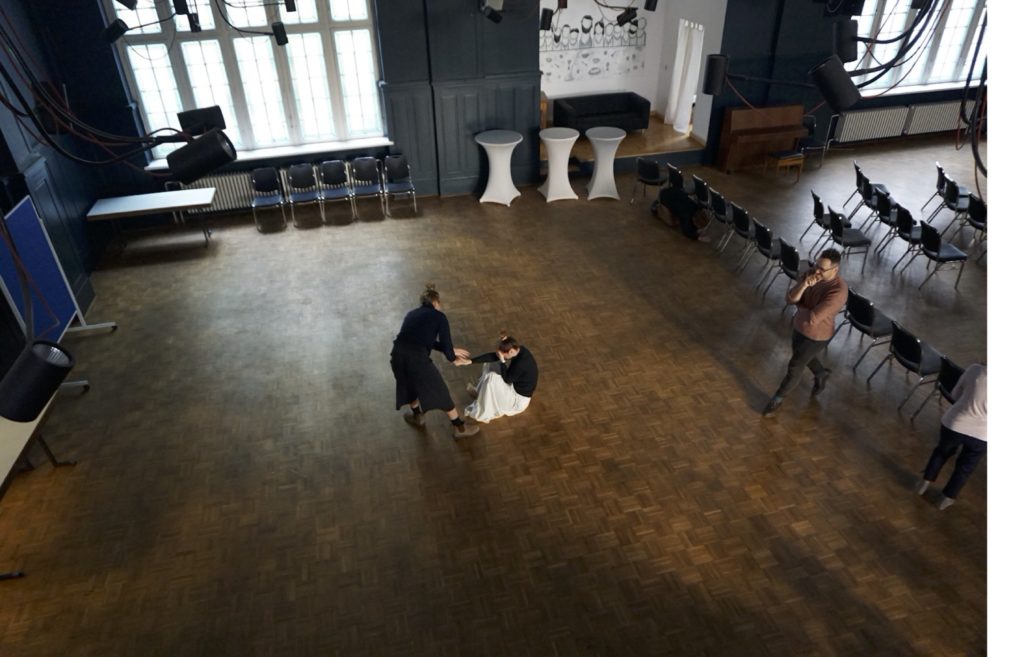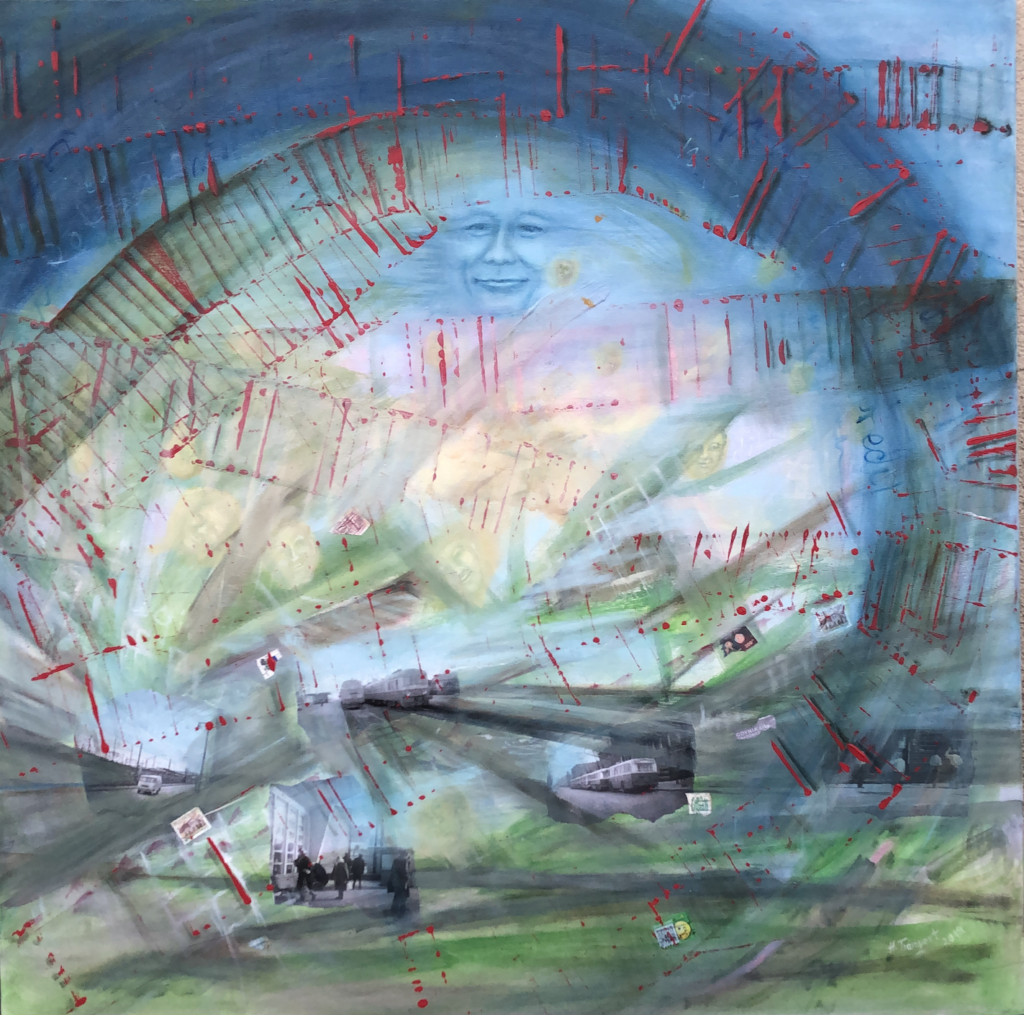In September and October 2019, our memory workshops ran across 4 sites – Berlin, Riga, Helsinki and Mexico City. We were excited to meet participants in person after getting to know everyone a little bit through online workshops and our online workspace on Slack. Alongside generating memory stories through sharing, discussion and writing, we also incorporated site-specific arts-based experiments and visits to exhibitions and theater.
We decided to use collective biography (Davies and Gannon, 2006) as a methodology to produce memory stories as we have found it fertile in our earlier to intimate events in our life as children. However, the scale of this project posed challenges and we were also interested in introducing new modes of engagements through art.
Collective biography has developed as an intimate, embodied generative methodology that moves from abstract or theoretical understandings of experience into narrative vignettes. It relies on trust and its processes build intellectual and affective relationships between small groups of researchers who are also simultaneously research subjects (Davies & Gannon, 2006, 2012; Haug et al., 1987; Haug, 1999). Although there is some flexibility in terms of process, advice about the size of memory work collectives has remained relatively consistent, no more than about 10 participants in one workshop. Since the memory workshops recollect and examine micro-moments and micro-processes of subject formation, discursive effects, relational, affective, and material entanglements, it would seem that they require small scale intimate work.
However, collective biography also means the ‘constant undoing of method as is reinvented again and again for each particular context, purpose and group of researchers’ (Gonick & Gannon, 2014). In almost all of our groups we have exceeded this recommended number. In Berlin we worked in two groups with 27 participants, in Riga 14 participants, in Helsinki 16 participants and in Mexico city with 10 participants. ‘Upscaling’ collective biography workshops to a much larger group of participants somewhat limited the time we could spend on discussing each memory story, but the larger group also allowed differences to come into view while still creating an intimate and trusting atmosphere for sharing memory stories.
The task set before us seemed to create a quick possibility for a relatively easy, un-self-conscious kind of intimacy among the participants. (Participant 1)
It’s a very personal thing, my memories. I open up to strangers. I choose to do so. And your memories trigger more of mine. (Participant 2)
It was quite intimate to share my own childhood memories, which brought surprisingly lot of emotions that I hadn’t expected at all. (Participant3)
We worked at multiple sites and across multiple differences, including language, culture, academic and artist participants, multiple generations and so on, and with people who were strangers to one another when they met in person on the first day of the onsite workshops. Connecting multiple workshops to explore a common theme: ‘childhood crossing divides’ yielded a wide arrays of stories, brought into view unexpected connections, similarities and the diversity of experience in different contexts and time-spaces. The upscaled collective biography has enabled us to respond to the monumental scale of a topic like childhood during the Cold War. Memory stories told about our shared humanity across divides and boundaries firmly set in place by historical walls and borders.
Merging art with collective biography
We have purposefully incorporated artistic modalities into our memory work, including storyboards, body movement, photo-work, photo-walking tour, mud-maps and theater-inspired activities to engage the body, senses, reassemble visual cues, work with affect and emotions in different expressive realms.
These art workshops have emerged from participants’ experience in theatre, acting, performing, photography, film making, painting, and drawing. One group visited the Homo Novus exhibition, a part of the 2019 Riga Theater Festival. The Helsinki group saw the ‘Body Interrupted’ experimental play. Art engagements elicited further memory stories, often those that were stored in visual or embodied ways.
Memory stories and connections
During the online and onsite workshops, and through the online environment, we have collected about 150 memory stories so far about childhoods lived during and after state socialism on both sides of the Iron Curtain. Memory stories bring into coherence our changing sense of who we are and who we were, thus offers postsocialist subjects a sense of personal coherence. Of course, this is not always semantically unified or emotionally pleasurable. During the workshops, many connections and friendships between participants have emerged. Participants prepared for the workshops with specific memories on a collectively agreed theme and brought objects and photos for the mini-exhibitions we held. As we worked with memories, other memories emerged through connections between spaces, times, objects, feelings and shared experiences. As one participant put it: “hearing that my experience was not unique” was the most surprising!
Some participants unexpectedly remembered that they once knew how to fly, something that they’ve done as children but forgot as they grew older. Others realized how their parallel lives had actually intersected, for example through encounters with the train under East Berlin or furniture they have desired or made, yet others shared memories of becoming girls, learning about politics, keeping secrets and so on.
I found the comparative component to be the most engaging. It was wonderful to see the themes emerge from our childhoods across a vast geographical scope, and in fact it showed me that many of the features that we thought of as distinct to our respective contexts (cultures, countries, socioeconomic background, etc.) were in fact perhaps more universal to the human condition across a generation. (Participant 4)
Seeing the connections between different stories was like magic, said Astra Zoldnere, one of the project participants who is also a film director. She further explained how amazing it was to realize that individual memory stories are actually a part of a much larger picture. Kasia Gawlicz commented on the Berlin workshop comparing it to other types of academic engagements.
Working with connections
Towards the end of the workshops, we have discussed ideas for academic and artistic projects, including a theatre play and traveling exhibition. We will be further discussing these ideas during the February 2020 Advisory Board meeting. Participants also agreed to continue memory work through academic writing (both individual and collective), artwork, blogs, children’s stories and novels, coordinated by the project team. Some of our workshop participants have been inspired to incorporate memory methods in their own academic and artistic work as well. We are very pleased with these developments, as they create further connections and multiply the interest and engagements between memories of childhood during the Cold War and people’s lives today.
Written memories, objects, photos, voice, and video-recorded memories and artworks assembled through the workshops, and continuously collected, will be curated by the Werstas / Lenin museum. Our aim is to showcase multiple histories and shared experiences of childhood on both sides of the Iron Curtain and during state socialism and in post-socialist spaces. In the ‘storytelling cafe’, memories transpired during the visit will continue in conversations. The exhibition intends to trouble ossified and one-sided views about a highly ideologically shaped childhood that neglected children’s agencies and their everyday lives. As one of our participants evocatively summarized:
…the time period of the Cold War–whether in Eastern Europe or in Latin America or in the US- is marked by divisions, binaries, propaganda, and constructed ideals of the Other. Having this sustained opportunity to break down those binaries, complicate or subvert our expectations, and reveal the commonalities that seemed to prevail despite the Iron Curtain, or dictatorships, was a very generative practice and really transformed the way that I think about Cold War childhoods.
Our collaborators, the Dollardaddy Theatre Group from Budapest, Hungary, inspired by the memory stories write and perform a play. The play will open in Hungary at Trafo Theatre on Budapest on the 23rd of September 2020 together with a small exhibition to create an atmosphere for the play. The play will travel to Tampere Workers Theatre and will be performed between 10-12th of February 2021. At the same time a large exhibition in Werstas Museum will open and will be on display until October 2021. The play will be performed last at the Comparative and International Society’s conference in Seattle on the 25th of April 2021, then it will be transformed into a TV drama.
We develop a digital archive of memories, objects, photos and videos. Unlike traditional archives, which represent a static collection of historical artifacts that represent a specific moment in time situated in the past, the anarchive transforms collecting of materials into an organic, ongoing activity in the present moment. Our anarchive seeks to provide viewers with new understandings of childhoods in the present moment and invites various modalities of representations that reflect or illustrate an experiences. The anarchive is a collective endeavor as it emerges from a cumulative, shared venture. It is designed to be in motion, to continually recreate itself, to incite experimentation, and to foster multiple, even panoramic viewpoints.
We complete the funded project during the autumn of 2021 with a satellite conference on 20-21st of October 2021. The conference aims to bring workshop participants together again and expand its scope to artists and academics interested in memories of childhood. Please stay tuned for our call for papers.
We are excited to see these projects to completion. Memories of childhood reveal connections and shared experiences and connect with children’s lives today. Childhood itself is a metaphor for the future and hope. Socialist future represented by childhood was bright often occluding real childhood experiences. Cultural associations and affective relations mobilized around the image of the child today also produce powerful visions of the future. Our project aims to shed light on these visions and connect those with our present, shared histories and future.




